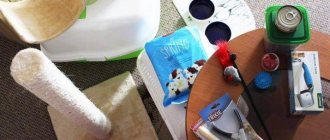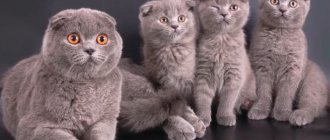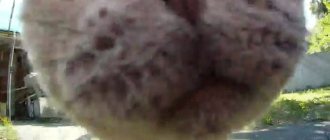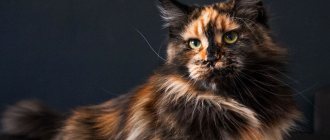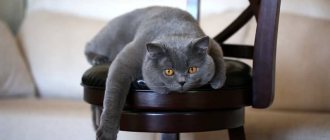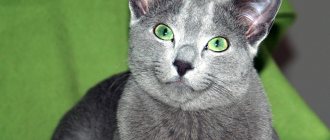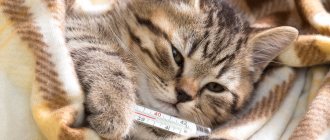Scottish cats delight with their toy appearance; they are welcome pets in many homes. The majority of Scottish cats are healthy and immune-strong individuals. However, owners need to know what diseases occur in Scottish cats in order to diagnose them in time and send their pet to a doctor for treatment.
But even if no symptoms are observed, a visit to the veterinarian for preventive purposes will not hurt.
Main types of diseases among Scots
In many ways, the health of the Scottish Straight depends on the cat's nutrition. Also, the owner should pay attention to the appearance of the fur and the cleanliness of the tear and ear canals. Most diseases in Folds occur due to a mutation that affects not only the shape of the ears. But straight-eared Scots, like other breeds, have no fewer possible diseases.
A kitten's dry nose may indicate a problem; however, it may be due to physiological reasons. During sleep or after, in a hot room this is normal. If your kitten has a dry nose, measure its temperature; an elevated temperature indicates the presence of a virus. The acceptable temperature for cats is about 38.5 degrees.
Diarrhea and vomiting can cause dehydration, which will also result in a dry nose. Diarrhea is caused by a change in food, intolerance, parasites, and various infections.
When a kitten sneezes and runs from its mouth and nose, it is a viral disease. The reasons why a cat is drooling can be: diseases of the oral cavity, poisoning, rabies, inflammation of the stomach or liver, the influence of allergens, a foreign body in the throat. A Scottish cat may be allergic to medications or new food.
Up to six months, pets' teeth change, and sometimes gum inflammation occurs. The peculiarity of the Scots is that the cat has a hanging belly. This is a structural feature. If your cat's tail is hanging, you shouldn't be alarmed; it's not necessarily a consequence of overeating. The Scots have skin hanging on their stomachs, even with obvious dystrophy.
The spine of a healthy cat should be straight; if the animal is hunchbacked, this is an alarm bell; there may be a genetic disease of the skeletal system.
Urolithiasis or urolithiasis (abbreviated urolithiasis) is the most common cause of death in cats of all breeds. Symptoms of the disease: pinkish color of urine, frequent, painful urination, apathy, cats lose weight. Similar pet behavior causes cystitis or is explained by urological syndrome.
Baldness is quite rare, the causes can be allergic, endocrine, infectious and parasitic. The Scottish cat snores, this is not uncommon, this is due to the characteristic structure of the nose.
Pathological skin condition
Among Scottish straight-eared and fold-eared cats, disorders associated with skin diseases are often encountered: allergic reactions, scabies and eczema.
The symptoms of skin pathologies are similar:
- severe itching appears;
- the integument turns red;
- possible peeling;
- wounds and scratches form;
- in advanced cases the animal goes bald.
Allergic reactions are caused by food that is unsuitable for your pet or by allergens in the environment. If food intolerance is detected, the animal's diet should be changed. If changing the diet does not affect the cat’s condition, then you need to ask a specialist for help.
▲ to contents
Eye pathologies
If your Scottish Fold cat's eyes are watery, this may indicate that an infection is developing. Especially often in representatives of the Scottish breed, the kitten's eyes become watery. The baby cannot carry out proper hygiene on his own, and his eyes fester.
In addition, immunity is often reduced in infancy. You can wash your eyes with special drops or tea. If dark discharge collects in the corners, dirt may have entered. Wait a few days, and if the brown discharge from the eyes does not stop, then rinsing will no longer help, you need to contact a veterinarian.
Quite often, owners wonder why a Scottish kitten’s eyes are watery. Fold cats have such a facial structure that they are often born with a congenital eyelid defect. In this case, the edge of the eyelid with eyelashes bends or turns out, touching the eyeball and causing lacrimation.
One of the reasons why a cat's eyes are watery is the presence of parasites in the body. The tearing will go away after deworming.
Description of the breed
Thanks to its touching appearance and positive disposition, the Scottish Fold is one of the most popular breeds all over the world. According to experts, representatives of the breed score the highest points in terms of affection, sociability, level of friendliness and intelligence. There are 4 subspecies of the Scottish Fold breed, differing in the length of their coat and the degree of deformation of the ear cartilage. Other exterior and phenotypic characteristics are similar. The presence of the lop ear gene in a Scottish Fold may mean the presence of hereditary problems with the development of joints and skeletal bones. These characteristics of the breed must be taken into account when caring for pets, minimizing risks in all available ways.
Appearance - what does a Scottish Fold look like?
Today, descriptions of the appearance of the Scottish Fold are used, proposed by various associations (including WCF, CFA TICA, IFA). In terms of basic positions, they are similar. This is a medium-sized cat with a strong build and a softly rounded silhouette.
- The Scottish Fold's head is round in shape and, when viewed from above, domed. The massive lower part is formed by a strong chin, rounded, plump cheeks, and large whisker pads. The frontal part is high and wide, the bridge of the nose is short and straight. The stop line is clearly visible. The nose is small, pigmented in accordance with the color.
- The small ears of the Scottish Fold have a tight fold (or several folds) that gives them a forward and downward direction. The tips are well rounded. The supply of ears is quite wide. The ears should not violate the contours of the head, emphasizing its rounded shape.
- Wide-set eyes – large and round, wide open. Eye color should match the main color.
- The neck is proportional to the body, strong, muscular and short.
- The body of the Scottish Fold is slightly elongated, with a well-developed broad chest. Being of a strong build, the Scottish Fold is not without grace. This distinguishes it from the British type. The legs are medium or short, strong and slender, with small, neat paws.
- The tail is of medium length. Powerful at the base, thinner and rounded towards the tip. A tail that is too thick, immobile and sensitive may indicate a genetic problem. Scottish folds with this feature are disqualified.
Kittens with varying degrees of lop ears are born in the same litter:
- single – the very ends of the ears are bent;
- double – there are two bends of the ear cartilage;
- triple - three bends (the ears are pressed so tightly to the body that it seems like they are completely absent).
All Scottish Fold kittens are born with straight ears. Some kittens from the litter will remain straight-eared (Scottish Straight). How to tell if a kitten is fold-eared or not? The fact is that kittens' ears droop at about three weeks of age. Straight ears are small in size, widely spaced, wide at the base and with sharp tips. The Scottish's ears should always be small enough so as not to disturb the round shape of the head.
Size
The body length of the Scottish Fold from the tip of the nose to the base of the tail is from 50 to 55 cm, with a height at the withers of up to 30 cm. The body length, including the tail, is 75-80 cm.
Weight
The weight of an adult Scottish Fold cat, according to the standard, ranges from 4.8 to 7.1 kg. Thanks to their thinner bones, cats are more graceful. Their weight is 4.5-7.0 kg. Sexual dimorphism is quite pronounced and manifests itself starting from infancy. This can be seen by looking at the Scottish Fold weight table by month.
Kitten weight by month (table):
| Age | Scottish Fold cat (kg) | Scottish fold cat (kg) |
| 1 month | 0.35 — 0.6 | 0.4 — 0.7 |
| 2 | 0.45 — 0.75 | 0.8 — 1.6 |
| 3 | 1.2-1.65 | 1.35 — 2.45 |
| 4 | 1.7 — 2.3 | 2.1 — 3.8 |
| 5 | 2.2 — 3.2 | 2.4 — 4.2 |
| 6 | 2.3 — 3.6 | 2.9 — 5.56 |
| 8 | 2.8 — 4.3 | 3.45 — 6.2 |
| 10 | 3 — 4.64 | 4.2 — 7.2 |
| 12 | 3.2 — 5.4 | 4.6 — 7.4 |
| 24 | 3.44 — 5.6 | 5.4 — 8.2 |
Scottish Folds reach adult weight at 2 years of age, when puberty begins.
Wool
Depending on the length of the coat, two subspecies of the Scottish Fold breed are distinguished.
- Scottish Fold (shorthair) - cats with two-part, thick hair. The outer hair is short and soft, giving a plush feeling to the touch. Thanks to the thick, downy undercoat, the outer hairs are vertical. As a result, the shorthair cat is quite fluffy.
- Highland Fold (long-haired) has wool up to 5 cm long. The outer coat has a soft, silky structure and, thanks to the thick undercoat, does not adhere tightly to the body.
The texture of the coat of both longhaired and shorthaired varieties varies depending on the season, color type, climate and lifestyle.
Colors
A distinctive feature of Scottish Fold cats is their extraordinary variety of colors. The standard imposes certain requirements regarding the combination of coat color with the shade of the iris, nose and paw pads. Violation of this combination will result in a reduction in the qualifying mark at the exhibition.
- Black color. Pure black color of the coat and nose is allowed, without the presence of any colored spots. The black Scottish Fold's eyes are golden or dark honey.
- The white Scottish Fold has a snow-white coat, without spots or colored inclusions. A brightly colored iris is welcome. Acceptable colors are blue, orange, amber, copper. White Scottish Folds may have heterochromia.
- Blue or gray color. Blue Scottish Fold wool should be brightly and uniformly colored. The color of the iris is yellowish or copper.
- Red or tan coloring is rare in Scottish Folds. Individuals with tail stripes will be disqualified.
- Cream or peach color is very valuable. A striped pattern on the paws or tail is possible.
- Purple fur (aka café au lait) should be combined with yellow or amber eyes. The nose is beige or light brown.
- Fawn is a smoky fawn color with a chocolate tint. The nose and paw pads are light pink.
- Chocolate is a rare and beautiful color. Adult Scottish Folds are characterized by dark chocolate shades.
- Cinnamon is a rare and expensive color. It is cinnamon with the addition of cocoa. The nose and paw pads of Scottish Folds should be bright pink with a brownish tint.
- Scottish Folds are bicolor with a white base color. The paws, muzzle, collar, chest and belly are painted in it. The paired color can be any. Eyes – amber or honey.
- Paticolor combines white and tortoiseshell or white and tabby or tabby-brown (tri-color coat).
- Elegant harlequin – black and white. This Scottish Fold has a white body combined with black paws, tail and head area. The nose is pink.
- The Van color is known for its colored tail and several colored spots on the head. Red van (red or copper spots) is more valuable than others.
- Colorpoints have colored tan markings. Possible shades of wool are chocolate, cream, red, blue, lilac. The color point color, where the main color is white, is especially valued among Scottish Folds. The eyes must be bright blue.
- The ticked color is formed by zonally dyed wool. There are options: red, blue, black, silver. The color of the iris is amber, yellow, copper, green.
- Tabby is a striped color. Marble or tiger varieties are possible.
- Chinchillas are not a natural, but an artificially bred color. Scottish Folds have tortoiseshell, bicolor, and smoky colors. The peculiarity of the color is a light or white undercoat, a dark mask on the muzzle in the form of a dark border around the eyes, nose and lips. When coloring a chinchilla, a hazel tint to the eyes is not acceptable.
Pathologies of the skeletal system
A terrible hereditary disease is osteochondrodysplasia of Scottish fold cats. OCD is characterized by deformation of bones and cartilage, or bones do not grow at all. Treatment can only be as supportive therapy; unfortunately, the disease is fatal.
Osteochondrodystrophy, a disease that causes skeletal deformation, also cannot be cured; it is unlikely that it will be possible to make your pet’s life happier. Symptoms may include a stiff tail and crooked legs.
Folds also suffer from sore joints. Signs of osteochondrosis in cats usually appear after five years.
Diseases in the abdominal area
Disturbances in the functioning of internal organs, as a rule, develop by a certain age, on average after reaching 10 years. The vulnerable organs of Scottish cats include the digestive and cardiovascular sections.
Digestive problems develop as a result of intolerance to certain components of the feed, the presence of parasites, and the formation of neoplasms or tumors. To prevent diseases, you need to feed your pet super-premium food or carefully selected natural products.
Cardiac pathologies occur in overweight cats: the organ cannot withstand the increased load. To avoid obesity, you should control the amount of food you eat and keep your pet active by offering outdoor games.
07/23/2021238 6 months ago
Vaccination of Scots
Even an animal that never goes outside can become infected with a serious virus. Vaccinations for Scottish Fold kittens are not 100% guaranteed, but the risk of complications will be minimal. According to veterinarians, too early vaccination is not always good or justified.
In turn, maternal immunity transferred to the baby weakens after 3 months. Therefore, the first vaccination for a Scots kitten should be done at this time. The first vaccines for cats are given against rabies or a complex one against several diseases; vaccination is mandatory.
Before the procedure, perform deworming. Because the first vaccination for a kitten can be given if the animal is in absolute health. You can decide when to give kittens the next vaccinations by consulting with your veterinarian or by following the vaccination schedule.
The vaccination calendar gives a clear picture of what vaccinations are given to Scottish kittens and when, at what age. There are not many of them; up to a year old, Scottish cats need to be vaccinated against microsporia, calicivirus, panleukopenia, calicivirus infection and rhinotracheitis.
The animal should be vaccinated before mating, visiting exhibitions, or traveling to the country. Scottish Fold kittens are vaccinated both Russian-made and imported. After sterilization, you should wait about two weeks for vaccinations.
A pet that has been vaccinated should be protected from possible sources of disease, which can lead to complications.
Vitamins
Proper care of cats helps them develop harmoniously, be healthy and beautiful. Vitamins for kittens will allow them to be strong and active.
Up to six months, babies especially need fish oil (vit. D, A). There are specially developed vitamins for Scots, selected taking into account the age and condition of the animal.
Trauma is the most common cause of lameness in cats.
Cats are by nature very active and curious. These qualities often play a cruel joke on them. While examining unfamiliar objects, they can receive various injuries: open injuries to the skin and soft tissues, dislocations, sprains and torn ligaments, bone fractures and joint injuries. If your four-legged pet suddenly becomes lame, the cause of the lameness probably lies in one of the listed problems.
Soft tissue damage
Fights with relatives and contact with sharp objects can lead to damage to soft tissues. This condition, in addition to lameness, is accompanied by bleeding of varying degrees of intensity, redness of surrounding tissues, and acute pain. Traumatic swelling often occurs, which over time turns into purulent inflammation. The appearance of pus poses the greatest danger.
If the wound is deep and extensive, surgery is required. Injuries received within a few hours before contacting a veterinarian are disinfected and closed with a blind suture. If more time has passed since the injury or there are signs of wound infection, treatment includes the use of antibacterial, anti-inflammatory and analgesic veterinary medications.
If you notice that your pet is pressing its front or back paw, you need to examine it. If there is a wound, it should be treated with any available antiseptic and try to stop the bleeding yourself, and then take the animal to the veterinary clinic.
Dislocations, sprains and ligament tears
Cats group well when jumping, trying to land on their paws. However, they are not always able to group correctly, and if the landing is unsuccessful, dislocation or damage to the ligaments is possible. These are rare injuries for felines, but their possibility cannot be completely ruled out. Information about them is presented in the table:
| Type of limb injury | Symptoms | First aid | Treatment | |
| Dislocation | Loss of support ability of the affected paw, swelling, asymmetry and deformation of the contours of the damaged joint | Immobilize the affected limb, apply ice for 10–15 minutes, temporarily stop feeding | Closed or open reduction and fixation using immobilizing bandages or splints. | |
| Ligament damage | Stretching | Lameness, shooting pain, in which the animal squints and twitches, trying to lean on the sore paw, the “drawer” effect (the joint is loose, the bones “play”) | Immobilization of the injured limb | Surgical repair of a damaged ligament. |
| Gap |
Bone fractures and joint injuries
Signs of injury:
- lameness;
- violation of skin integrity and bleeding (with an open fracture);
- pain;
- change in the natural position of the damaged paw;
- crunch when palpated.
Before transporting your pet to the veterinary clinic, you must:
- remove dirt and bone fragments from the wound and stop bleeding by pressing a finger wrapped in a clean napkin to the wound;
- disinfect the affected area;
- immobilize the injured limb by placing a board or wide ruler on it and securing a homemade splint with a bandage, belt or belt.
The cat must be transported to the veterinary clinic while lying down, placing it on a hard, flat surface. Closed and uncomplicated fractures are treated conservatively, complex injuries are treated surgically.
How long do Scottish fold cats live?
The life expectancy of Scottish Fold cats at home with proper care is 15-18 years. How long Scottish fold or straight-eared people live is determined by their innate immunity and the presence of hereditary diseases.
The quality of life of a Scottish dog depends on whether the owner pays attention to the diet, the animal’s mobility, and whether he carries out vaccinations and preventive examinations on time.
Thus, how long a Scottish fold cat lives depends on many factors; some individuals delight owners for more than 20 years.
Attitude towards children
Scottish Folds are an amazing breed, because aggression is completely uncharacteristic for them. They make excellent playmates for children. You can safely leave your child next to your pet and be sure that he will not bite or scratch you. In the case of an unceremonious attitude, the Scottish Fold will simply withdraw from communication, run away or hide.
For playing with children, it is recommended to take grown-up Scottish Fold kittens into the family. At this age they are highly trainable. The kids will be interested in learning a few tricks with their pet, and then demonstrating their success in front of other family members.
Playfulness
The Scottish Fold cannot be called a hyperactive breed, although young kittens are very playful. By nature they are excellent hunters. Hunting is the main activity for animals living in the wild. Games that simulate a chase help the Scottish Fold to maintain physical fitness and spur the instinct of a wild animal.
Movement and play are essential components of the physical and emotional health of the Scottish Fold. In addition, the game for a kitten is a method of studying the world around us and those who live in it.
Cost of kittens
Each kitten has an exhibition class, which determines the degree of compliance with the breed standard. This is an important criterion for pricing:
- PET-class are purebred animals whose exterior does not quite meet the standard. PET Scottish Folds are wonderful friends at home. The cost of kittens is from 15 to 20 thousand rubles.
- BREED class - Scottish folds with exterior deviations. They are accepted into the breeding program because they are capable of producing quality SHOW animals. Kittens cost 20-30 thousand rubles.
- SHOW-class – purebred kittens with impeccable pedigree and appearance, born from award-winning sires. Their cost is 30-60 thousand rubles.
- TOP SHOW-class - have the standard qualities of the breed, confirmed by experts. Such kittens are sold at the highest prices - from 60 to 100 thousand rubles. Often, they are left in nurseries for further breeding work.
Scottish Fold kittens without pedigree cost from 4 to 6 thousand rubles. But, in this case, there is a risk of serious genetic abnormalities.
How to cope with loneliness
The little Scottish Fold constantly needs the attention of its owner. He feels safe next to his owner. Left to their own devices, the kittens begin to look for something to do, which results in small domestic pogroms. To prevent this from happening, the kids are occupied with toys and bought treats. House flowers, shoes, wires are hidden or covered.
An adult Scottish Fold may experience loneliness in different ways. Each animal is not devoid of individuality, and the reaction to the same situation can be completely different. One pet can endure loneliness very hard, while another will sleep peacefully all day until the owner arrives.
Similar breeds
- The British Shorthair cat resembles the Scottish Fold in appearance with its round muzzle, tightly knit body, and thick, short, plush-like fur. She is independent, but at the same time, attached to a person. The pet has a phlegmatic disposition, and after reaching maturity it prefers to lead a quiet lifestyle. Unlike the Scots, the British are a natural breed and therefore have excellent health. The British Shorthair was used in the development of the Scottish Fold. In this regard, the breeds are considered related.
- Among cats with unusual ear shapes, American Curls . His ears are not flattened like Scottish ears, but rather turned inside out. The ancestor of curls is considered to be the mongrel cat Shulamith. Her ears, thanks to a mutation, had an unusual shape. The gene that caused the mutation did not affect the general health of the pets, which enabled the breed to actively develop. There are two subspecies of curls with long and short hair. Curls are distinguished by their flexible and sociable disposition. Along with the Scottish, they are considered one of the best positive breeds of domestic cats.
Maintenance cost
Privileged socialization and a comfortable life for the Scottish Fold in the house begin with the preliminary organization of the house and the acquisition of a basic set of cat accessories:
- Bed or house – 2000-3000 rubles.
- Tray - about 1500 rubles.
- Filler (clay or wood is recommended for kittens) – 280 RUR
- Bowls for food and water – 1000 rubles.
- Scratching post – 294 rub.
- Harness and leash for walking – 483 RUR
- Carrying – 660 rub.
- Toys - about 500 rubles.
Total: 11172 rub.
Nutrition
If an industrial diet is chosen, your pet will need four kilograms of dry food per month.
A two-kilogram pack of Natural Greatness “Field&River Recipe” food costs 1,986 rubles.
1986x2= 3964 rub.
When feeding with natural food, you will need about 7 kg of meat or offal worth about 2000 rubles.
Additional products will cost about the same.
2000x2=4000 rub.
Veterinary
The Scottish Fold should be taken to the veterinarian every year to assess its health. In addition, the animal is vaccinated annually with a complex vaccine, dewormed and protected against fleas and ticks.
- Medical examination of a young Scottish Fold on average (external examination, general blood test, selection of diet, recommendations) – 5,000 rubles.
- Vaccination (panleukopenia, rhinotracheitis, calcevirosis, chlamydia) – 1500 rubles.
- Comprehensive protection against helminths, fleas, ticks, ear mites - stronghold drug (drops on the withers) - 450 rubles. (the drug is applied 2 times a year)
Total: 7400 rub.
If Scottish Fold disease occurs, costs will increase significantly.
- Simple operation - from 20,000 rubles.
- Hospital stay – 5500
Total: 36,500 rub. 3 days in hospital + surgery
Grooming
The coat of the Scottish Fold needs to be cared for regularly, so you will have to purchase a small kit in advance for high-quality combing and bathing procedures. In addition, you will need to care for your ears, eyes, teeth, and claws:
- Fuminator FURminator for short-haired cats – RUB 1,976.
- Glove for combing cats – 178 RUR.
- Nail clippers with bottom lock – 193 RUR.
- Hypoallergenic shampoo for cats Elite Organic – 599 RUR.
- “Otokeya” ear lotion, cleansing – 195 RUR.
- Cliny eye lotion – 259 RUR.
Total: 3400 rub.
Exhibitions
The total cost of participation in the Scottish Fold exhibition depends on the size of the entry fee, the class of the event, how many cats will participate in the event, the number of days of presence, and transportation costs. Approximately, the costs of participating in the exhibition will look like this.
- Exhibition fee – 2500 rubles.
- Certificate from a veterinarian – 600 rubles.
- Preparation of the animal - 3000 rubles.
- Exhibition tent – 5000 rub.
- Folding tray, filler, bed, diapers, water, food - 3000-4000 rubles.
- Participation in rings and shows – 500 rubles.
Total: 15,600 rub.

